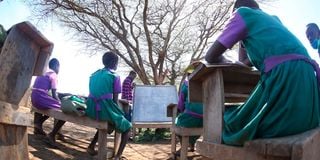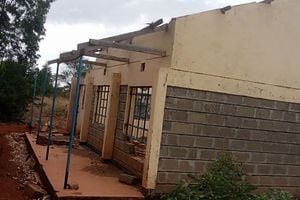
Salabani Primary School in Marigat, Baringo County.
In 2020 when Lake Baringo and Lake Bogoria burst their banks causing massive flooding and displacement of people, several schools were relocated for the safety of learners and teachers.
The move was to ensure that learning continued in the schools that were affected by floods in Baringo South and Baringo North sub-counties.
What the planners did not visualise, however, was the distance that learners had to cover to get to their new institutions, and also their safety after it emerged that some schools had been moved to a border area that was prone to banditry.
Four years later, the new schools have turned into white elephants, after learners and their teachers abandoned them and returned to their former schools, citing long distances and safety.
Among the affected institutions were Salabani Secondary School, Ng’ambo Girls’ Secondary School, Lake Baringo Mixed Secondary School, Ng’ambo Primary School, Sintaan, Leswa, Lorok, Loropil, Noosukro, Kiserian, Loruk, Ilng’arua, Ng’enyin, Sokotei and Salabani primary schools.
Following the floods in 2020, the government urged parents in the affected schools to look for alternative locations in safer areas for the construction of new learning facilities.
Salabani Primary School received Sh30 million from the Child Fund, while Salabani, Ng’ambo, and Lake Baringo Secondary Schools received Sh5 million from the Ministry of Education for their reconstruction in the new sites. Loruk and Sintaan primary schools in Baringo North and Baringo South sub-counties were also required to relocate to new locations.
At Loruk Primary, the boys’ dormitory with a capacity of 80 pupils, the pit latrines and the entire playing field were swallowed by the flood waters, forcing learners to use canoes to access the institution after the main roads were also submerged.

Grade four pupils of Ng'ambo Primary School study under a tree in Seriani in Baringo South on January 4, 2021.
“To remedy the situation, the government relocated the institution to the safer Cherelyo village more than five kilometres away, resulting in the construction of a Sh4.6 million boys’ dormitory,” headteacher Isaac Rerimoi told Nation.Africa.
After the construction of the facility, however, parents complained that the new location was too far from the villages where they live and at a common border prone to bandit attacks and stock theft.
Nation.Africa established that despite the government investment in the dormitory, the project turned into a white elephant as learners returned to their former school when the Lake Baringo water levels receded.
Young learners
“The new dormitory was too far for the young learners and the boys are now sleeping in one of the classrooms. But we fear the school will be swallowed again if the waters keep rising,” said Mr Rerimoi.
At their former school, the learners are still grappling with the same challenge as Lake Baringo burst its banks again, submerging some structures at the institution.
“The water levels have increased tremendously in the past two months, swallowing the entire playing field,” said Mr Rerimoi.
The school has more than 60 boarders. Rising water levels present fears of wild animal attacks given the threat of hippos, crocodiles, and snakes.
According to Reverend Elijah Cheruiyot, the former chairman at the primary school, public participation was done and locals allocated more than 64 acres for the reconstruction of the school at the new site in Cherelyo village.
However, when the flood waters receded months after the government put up the boys’ dormitory, parents became adamant and proposed that their children continue learning in their former school.
“The new project sadly turned a white elephant despite the government spending a lot on its construction,” said Rev Cheruiyot.
According to the former school chairman, plans were underway for the government to put up more facilities at the new institution, but this was aborted after parents became rigid about moving their children back to the old location.
“We appeal to the government to improve security in the area and help us build classrooms at the new location so that the school can be moved to a safer area. As we see now, the institution is on the verge of being swallowed by the rising lake waters once more. The school is unsafe for children because of the hippos and crocodiles that roam in the compound,” Rev Cheruiyot said.
In flood-prone Baringo South, Sintaan Primary School had been moved to a safer location seven kilometres away, with the government pumping more than Sh2 million into the two classrooms.

Pupils of Sintaan Primary School in Baringo play in a flooded field.
Like Loruk, however, locals here also refused to move their children to the new location citing the long distance. They chose to remain at their old location, which once again flooded after water levels increased at the beginning of this year.
When Nation.Africa visited the school in July, and more than five classrooms had developed cracks due to the flooding.
The head teacher Stephen Olempakany said the cracks started in 2020 after the school was marooned in water and kept increasing.
"The cracks widened due to the recent flooding and our learners are at risk because their classrooms might come down anytime. We tried to renovate two classrooms in the past but the cracks kept widening," he said.
Former Baringo South Sub-County education director George Okeyo had said the plan flopped because the proposed new location for the school was four kilometres away, far from the village where locals live.
"The classrooms were not constructed because we didn't receive any funding for the project, but the area MP Charles Kamuren promised to allocate Sh500,000 and we are still waiting,” he had said.







